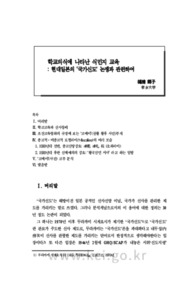

-
미리보기
서지정보
· 발행기관 : 한림대학교 일본학연구소
· 수록지 정보 : 한림일본학 (구 한림일본학연구) / 25호 / 59 ~ 76페이지
· 저자명 : 히우라 사토코
초록
신사, 신도를 역사적으로 서술하는 연구사의 시점은 오늘날까지 대부분 기독교 및 기독교계 사립학교의 신사참배 강요, 신앙 탄압 문제에 집중되어 있다. 그러나 식민지에 있어 강요한(받은) 것은 신사참배 뿐 만 아니라 (신사는 그다지 많은 지역에 설립되지 않았다), 지역사회에 존재하는 보통학교 안에 만들어진 신사를 대신하는 가미다나(神棚)와 가미다나에 모시는 신궁대마, 그리고 교육활동이라는 명목으로 강요한 배례(경례) 등, 폭넓은 강요 또는 폭력장치와 방법에 관한 문제로서 파악되어야 할 것이다.
본고는 이러한 견지에서 종교 강요 문제가 학교교육의 ‘세속성’ (비종교성) 원칙을 배경으로 가시화 되지 못한 채 존재해 왔다는 점을 지적하였다.
애초 일본교육에 있어 학교의례는 ‘국가제사’의 비종교적인 상시형으로, 일본 국내에서 밖에 통용되지 않는 특이한 제도였다. 그러던 것이 1930년대 중반 이후 조선에서, 종교 신앙적 측면이 큰 ‘오하라이’ 등이 공립학교 교육에 침투된다. 원래 신사참배는 ‘기도’ 라는 마음의 행위와 ‘가시와데(拍手=박수)’라는 신체행위가 동시에 포함되는 의례이다. 그러나 조선에서의 ‘황국신민 서사’ 와 같이 ‘목소리를 낸다’, ‘기립한다’ 와 같이 신체 의례적 측면만이 강조되는 방향으로 강화되어, 전시체제의 강화와 더불어 심각성을 더하게 된다. 이는 종교적 측면에서강당에 ‘교에이’를 걸고, 가미다나를 설치하여, 신체의례적 측면에서는 의례규정에 명시도지도 않은 ‘서사’를 순서에 끼워 넣는 임시방편을 택하여 미봉의 끝에 붕괴한 것이라 할 수 있다.
현대 일본에서 종교역사 연구는 식민지시기 연구를 중심으로 학교생활 속의 천황숭배 문제등 ‘풀뿌리’ 적인 일상생활 속에 묻혀 있던 문제를 다룸으로써 종교를 폭 넓은 의미에서의 역사적 과제로 다루고자 하는 움직임이 요구되고 있다.영어초록
State-Shinto [Kokka-Shinto] paradigm has long been discussed and reconsidered in modern Japan. One viewpoint is to grasp it restrictively as the term which means the prewar Jinja [Japanese Shrine] system that had been under the administrative control of the Imperial Japan’s government. On the contrary, another viewpoint is to understand this as broad framework, including school history or Imperial Rituals which sustained after WWII. This script stands on the latter viewpoint and tries to reconsider the colonial Korea’s school education.
The standpoints of extant research on Jinja-Shinto field have mainly focused on the problem of the compulsive shrine visitation and violent oppression toward Christians and their churches in Korea. However, it is not only Christians’ shrine visit that was compelled violently by colonial government or other colonial powers. For instance, Jinja shrine were not always existed all over Korean regional communities. Instead, it is important to review carefully such historical facts that many numbers of substitute equipment, which were made as small and inexpensive Jinja-typed apparatus, were set up in public school all over Korea. By taking a careful look at Imperial Japan’s school system, its textbooks and education methods, we can find some forms of broader compulsion than seen in the extant research.
When modern Japanese school system had been prepared in Meiji Era in mainland Japan, school rituals were made under the principle of non-religion. But this system could not be applied to colonial schools. In Korean schools, Emperor worship itself could not be understood as non-religion one even if school teachers would insist it as not. Under such situation, not only students’ shrine visit but opportunities to join shrine rituals, which were held not by schools but by shrines, were more and more increased. This went beyond the boundary between non-religion and religion.
On the one hand, as seen above, religious compulsion was emphasized day by day. But it is not only the form of oppression toward Korean residents. For example, the education method of "Imperial Subjects Oath”, which was forced only in Korea, tried to highlight the aspects of physical move such as saying it in a loud voice or standing upright position, on the other .Primarily Jinja-Sanpai consists of the two aspects at the same time. One is the mental pray and the other is physical clap. In spreading Japanese typed schools, various types of the violent enforcement with strange divergent of those two aspects came with them. When Imperial Japan’s school system, in which Emperor worship was its core, was once introduced and spread in Korea, lots of contradiction and logical impasse were continuously exposed. Japanese Government General cannot choose but respond with temporal expedients.참고자료
· 없음태그
-
자주묻는질문의 답변을 확인해 주세요

꼭 알아주세요
-
자료의 정보 및 내용의 진실성에 대하여 해피캠퍼스는 보증하지 않으며, 해당 정보 및 게시물 저작권과 기타 법적 책임은 자료 등록자에게 있습니다.
자료 및 게시물 내용의 불법적 이용, 무단 전재∙배포는 금지되어 있습니다.
저작권침해, 명예훼손 등 분쟁 요소 발견 시 고객센터의 저작권침해 신고센터를 이용해 주시기 바랍니다. -
해피캠퍼스는 구매자와 판매자 모두가 만족하는 서비스가 되도록 노력하고 있으며, 아래의 4가지 자료환불 조건을 꼭 확인해주시기 바랍니다.
파일오류 중복자료 저작권 없음 설명과 실제 내용 불일치 파일의 다운로드가 제대로 되지 않거나 파일형식에 맞는 프로그램으로 정상 작동하지 않는 경우 다른 자료와 70% 이상 내용이 일치하는 경우 (중복임을 확인할 수 있는 근거 필요함) 인터넷의 다른 사이트, 연구기관, 학교, 서적 등의 자료를 도용한 경우 자료의 설명과 실제 자료의 내용이 일치하지 않는 경우
“한림일본학 (구 한림일본학연구)”의 다른 논문도 확인해 보세요!
-
在朝日本人の怪談と探偵小説研究 : 怪談における〈謎解き〉と京城記者を中心に 25 페이지
本稿は、植民地時代の再朝鮮日本人によって出版された日本語の雑誌『朝鮮公論(朝鮮公論)』に掲載された怪談と探偵小説を分析し、植民地朝鮮における日本人大衆文藝の特徴とその娯楽性を考察したものである。近年、文学、民間伝承、比較文化などの研究分野で妖怪、幽霊、怪談などに関する研究が活発におこなわれている。そこで韓国のホラーブームおよび怪談の起源、そのイメージの変遷を論じる際に主に言及されるのが日本との関連.. -
志賀潔と植民地朝鮮 54 페이지
志賀潔(1871~1957年)は、赤痢菌の発見で著名な戦前日本の細菌学者である。しかし、志賀潔が、研究者としての後半生10数年間を植民地朝鮮で送ったことはほとんど知られていない。志賀は、1920年に朝鮮総督府医院長兼京城医学専門学校校長として朝鮮に渡った。1926年、京城帝国大学の創設においては、実現はしなかったもののアメリカ式の基礎医学と臨床医学の連繋を構想した。そして、京城帝国大学が開学すると.. -
가센에도상(歌仙絵図像)의 변천 : 출판문화 이전과 이후를 비교하며 30 페이지
본 논문은 헤이안 시대의 유명한 가인들의 모습을 그린 ‘가센에(歌仙絵)’라는 일본의 전통적 회화주제에 대한 연구이다. 가센에는 가마쿠라 시대의 에마키(絵巻)에 그려진 ‘삼십육가센(三十六歌仙)’을 시초로 하고, 이후 병풍, 족자, 편각, 책 등의 다양한 미디어에서 도상을 확인할 수 있다. 각 미디어를 바라보는 감상자의 시선이 정형적인 가센에도상 안에서 군상(.. -
植民地朝鮮における天理教の布教について :機関誌『みちのとも』を中心に 42 페이지
日本の諸宗教は、帝国日本の朝鮮侵略と歩調を合わせ、19世紀末から朝鮮半島への渡航を開始した。天理教は日本の新宗教の中で最も早く朝鮮半島に渡り、しかも現在までその命脈が保たれているものとして、その信仰の継承などについての研究が重ねられている。 本稿ではまずは統監府・朝鮮総督府の宗教政策を概観し、天理教の機関紙であった『みちのとも(道乃友)』の朝鮮半島布教に関する記事を中心に取り扱い、当時の天理教の.. -
환기와 소거, 그리고 일본어문학 : 김석범의 『1945년 여름』 22 페이지
본 논문은 일본 식민지에서 해방되어 25년이 지난 시점에서"1945년여름"을 환기하고, 일본어로 문학활동을 재기한 재일한국인 작가 김석범의 문학을 통해 해방과 패전이라는 관몀과 현실을 넘어 역사적인 기억을 작품 속에서 어떻게 풀어가고 있는가에 대하여, 즉 일본사회를 향해 질문을 던지는 김석범의 문제의식에 대해 고찰하하였다. "1945년 여름"은 김석범의 자..
문서 초안을 생성해주는 EasyAI

